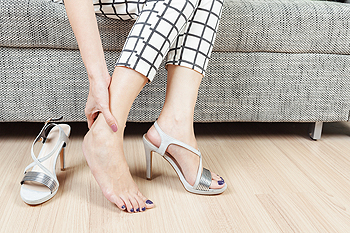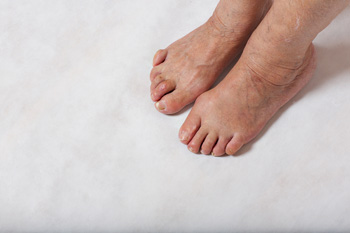Foot and Ankle Specialist
March 2022
Pump Bump
 High heeled shoes, often worn by women, can cause irritation to the back of the heel. This condition is known as Haglund’s deformity, or pump bump and can eventually lead to other problems, such as Achilles’ tendonitis or bursitis. Those who have high arches or tight Achilles tendons are especially vulnerable to pump bump from high heels. Not only is this a painful condition but the heel can swell and become red. Treatments include icing the back of the heel, anti-inflammatory medications, heel lifts in shoes, and stretching exercises. The best prevention is avoiding high heels. Should pain and discomfort from pump bumps persist, a visit to a podiatrist is suggested.
High heeled shoes, often worn by women, can cause irritation to the back of the heel. This condition is known as Haglund’s deformity, or pump bump and can eventually lead to other problems, such as Achilles’ tendonitis or bursitis. Those who have high arches or tight Achilles tendons are especially vulnerable to pump bump from high heels. Not only is this a painful condition but the heel can swell and become red. Treatments include icing the back of the heel, anti-inflammatory medications, heel lifts in shoes, and stretching exercises. The best prevention is avoiding high heels. Should pain and discomfort from pump bumps persist, a visit to a podiatrist is suggested.
High heels have a history of causing foot and ankle problems. If you have any concerns about your feet or ankles, contact Don A. Shumway, DPM from Arizona. Our doctor can provide the care you need to keep you pain-free and on your feet.
Effects of High Heels on the Feet
High heels are popular shoes among women because of their many styles and societal appeal. Despite this, high heels can still cause many health problems if worn too frequently.
Which Parts of My Body Will Be Affected by High Heels?
- Ankle Joints
- Achilles Tendon – May shorten and stiffen with prolonged wear
- Balls of the Feet
- Knees – Heels cause the knees to bend constantly, creating stress on them
- Back – They decrease the spine’s ability to absorb shock, which may lead to back pain. The vertebrae of the lower back may compress.
What Kinds of Foot Problems Can Develop from Wearing High Heels?
- Corns
- Calluses
- Hammertoe
- Bunions
- Morton’s Neuroma
- Plantar Fasciitis
How Can I Still Wear High Heels and Maintain Foot Health?
If you want to wear high heeled shoes, make sure that you are not wearing them every day, as this will help prevent long term physical problems. Try wearing thicker heels as opposed to stilettos to distribute weight more evenly across the feet. Always make sure you are wearing the proper shoes for the right occasion, such as sneakers for exercising. If you walk to work, try carrying your heels with you and changing into them once you arrive at work. Adding inserts to your heels can help cushion your feet and absorb shock. Full foot inserts or metatarsal pads are available.
If you have any questions please feel free to contact our office located in Snowflake, AZ . We offer the newest diagnostic and treatment technologies for all your foot and ankle needs.
Gout Pain Can Be Managed
The Pain in Your Ankle May Be Arthritis
 When you feel pain and swelling in the ankle that is not the direct result of an injury, it is likely caused by inflammatory, rheumatoid or crystal arthritis (gout). This condition can also be brought on as a side effect of a previously broken ankle or recurring ankle sprains from sports activities. Other symptoms include reduced mobility and a grinding noise when you move the joint. The main cause is a lack of cartilage, resulting in bone touching bone when you put any weight on your ankle. It may help to use a cane or other device, to take some of the weight off your lower extremities when you stand or walk. In addition, taking anti-inflammatory medication can help to reduce the pain. Wearing a brace to limit joint movement can also be effective. If the pain in your ankle continues or worsens, it is probably wise to make an appointment with a podiatrist, who can fully examine your ankle and offer other treatment options, depending on the severity of the arthritis.
When you feel pain and swelling in the ankle that is not the direct result of an injury, it is likely caused by inflammatory, rheumatoid or crystal arthritis (gout). This condition can also be brought on as a side effect of a previously broken ankle or recurring ankle sprains from sports activities. Other symptoms include reduced mobility and a grinding noise when you move the joint. The main cause is a lack of cartilage, resulting in bone touching bone when you put any weight on your ankle. It may help to use a cane or other device, to take some of the weight off your lower extremities when you stand or walk. In addition, taking anti-inflammatory medication can help to reduce the pain. Wearing a brace to limit joint movement can also be effective. If the pain in your ankle continues or worsens, it is probably wise to make an appointment with a podiatrist, who can fully examine your ankle and offer other treatment options, depending on the severity of the arthritis.
Ankle pain can be caused by a number of problems and may be potentially serious. If you have ankle pain, consult with Don A. Shumway, DPM from Arizona. Our doctor will assess your condition and provide you with quality foot and ankle treatment.
Ankle pain is any condition that causes pain in the ankle. Due to the fact that the ankle consists of tendons, muscles, bones, and ligaments, ankle pain can come from a number of different conditions.
Causes
The most common causes of ankle pain include:
- Types of arthritis (rheumatoid, osteoarthritis, and gout)
- Ankle sprains
- Broken ankles
- Achilles tendinitis
- Achilles tendon rupture
- Stress fractures
- Bursitis
- Tarsal tunnel syndrome
- Plantar fasciitis
Symptoms
Symptoms of ankle injury vary based upon the condition. Pain may include general pain and discomfort, swelling, aching, redness, bruising, burning or stabbing sensations, and/or loss of sensation.
Diagnosis
Due to the wide variety of potential causes of ankle pain, podiatrists will utilize a number of different methods to properly diagnose ankle pain. This can include asking for personal and family medical histories and of any recent injuries. Further diagnosis may include sensation tests, a physical examination, and potentially x-rays or other imaging tests.
Treatment
Just as the range of causes varies widely, so do treatments. Some more common treatments are rest, ice packs, keeping pressure off the foot, orthotics and braces, medication for inflammation and pain, and surgery.
If you have any questions, please feel free to contact our office located in Snowflake, AZ . We offer the newest diagnostic and treatment technologies for all your foot care needs.
Read more about Ankle Pain
Does Your Child Walk On the Outside of One Foot?
The tarsal navicular bone helps connect the ankle to other bones that are lower in the foot. This bone gets its nautical sounding name because it has a shape that is like a small boat. The navicular bone helps form and stabilize the arch and helps us walk efficiently. Kohler’s Disease is a rare bone disorder in which the navicular bone experiences a loss of blood supply and density, causing the bone to weaken and be susceptible to compression from other bones in the foot. This can affect some children typically aged 3-7, and it most commonly occurs in boys. The symptoms a child may experience with Kohler’s Disease include pain, tenderness, swelling, and redness in the middle of the foot. While this disorder may sound scary, the prognosis is usually good: Kohler’s Disease generally corrects itself as the child matures. Until that time, the child may compensate for the discomfort they are feeling by walking on the outside of the affected foot. If you see your child walking like this or even limping, it is wise to take them to a podiatrist for an examination and diagnosis. If their findings indicate that your child has Kohler’s Disease, the podiatrist can help treat the disorder and provide relief through techniques such as casting, anti-inflammatory medications, custom orthotics and special supportive footwear.
Making sure that your children maintain good foot health is very important as they grow. If you have any questions, contact Don A. Shumway, DPM of Arizona. Our doctor can provide the care you need to keep you pain-free and on your feet.
Keeping Children's Feet Healthy
Having healthy feet during childhood can help prevent medical problems later in life, namely in the back and legs. As children grow, their feet require different types of care. Here are some things to consider...
Although babies do not walk yet, it is still very important to take care of their feet.
Avoid putting tight shoes or socks on his or her feet.
Allow the baby to stretch and kick his or her feet to feel comfortable.
As a toddler, kids are now on the move and begin to develop differently. At this age, toddlers are getting a feel for walking, so don’t be alarmed if your toddler is unsteady or ‘walks funny’.
As your child gets older, it is important to teach them how to take care of their feet.
Show them proper hygiene to prevent infections such as fungus.
Be watchful for any pain or injury.
Have all injuries checked by a doctor as soon as possible.
Comfortable, protective shoes should always be worn, especially at play.
If you have any questions please feel free to contact our office located in Snowflake, AZ . We offer the newest diagnostic and treatment technologies for all your foot and ankle needs.
Read more about How to Care for Your Child's FeetWhat Is a Hammertoe?
A hammertoe is when a toe joint (usually the second or middle toe joint) points up instead of lying flat and causes the toe to look like a hammer. This condition can be painful and can lead to difficulty walking. The affected joint often gets rigid, the joint stiffens, sometimes to non-movement. Sometimes a corn or callus may develop on the joint and can cause pain and swelling on the top of the bent toe. This affliction can be caused by weak foot or leg muscles which lead to the tendon pulling up the toe in an abnormal position. Hammertoes are more apt to happen to those who wear high heels or shoes that do not properly support the feet. However, foot type at birth, those with neuromuscular disease, and trauma may predispose one to develop this joint deformity as well. If you think you have symptoms of a hammertoe, it is recommended that you see a qualified podiatrist as soon as possible for proper diagnosis and treatment.
Hammertoe
Hammertoes can be a painful condition to live with. For more information, contact Don A. Shumway, DPM from Arizona. Our doctor will answer any of your foot- and ankle-related questions.
Hammertoe is a foot deformity that affects the joints of the second, third, fourth, or fifth toes of your feet. It is a painful foot condition in which these toes curl and arch up, which can often lead to pain when wearing footwear.
Symptoms
- Pain in the affected toes
- Development of corns or calluses due to friction
- Inflammation
- Redness
- Contracture of the toes
Causes
Genetics – People who are genetically predisposed to hammertoe are often more susceptible
Arthritis – Because arthritis affects the joints in your toes, further deformities stemming from arthritis can occur
Trauma – Direct trauma to the toes could potentially lead to hammertoe
Ill-fitting shoes – Undue pressure on the front of the toes from ill-fitting shoes can potentially lead to the development of hammertoe
Treatment
Orthotics – Custom made inserts can be used to help relieve pressure placed on the toes and therefore relieve some of the pain associated with it
Medications – Oral medications such as anti-inflammatories or NSAIDs could be used to treat the pain and inflammation hammertoes causes. Injections of corticosteroids are also sometimes used
Surgery – In more severe cases where the hammertoes have become more rigid, foot surgery is a potential option
If you have any questions please contact our office located in Snowflake, AZ . We offer the newest diagnostic and treatment technologies for all your foot and ankle needs.
Read more about HammertoeWhat Is a Plantar Fascia Rupture?
A band of tissue that connects your heel to your toes, called the plantar fascia, often becomes inflamed and is one of the most common causes of heel pain. Sometimes this tissue can also rupture, which may feel like a tearing pain in the arch of the foot. It is usually the result of a sports-related injury, especially while jumping and landing, or making sudden stops and starts. Although a plantar fascia rupture is relatively uncommon, it is far more prevalent in people with chronic plantar fasciitis and flat feet, as well as those involved in football, basketball, dancing, tennis and soccer. Swelling, tenderness, and bruising are common symptoms of this type of injury. Weight-bearing on the affected foot is extremely painful and not recommended. A podiatrist can examine your foot to determine the severity of the injury, usually with an imaging test. Pain medication, icing the area, and wearing a protective boot to stabilize the foot are among the ways to treat such a rupture. It’s a good idea to make an appointment with your podiatrist as soon as possible for an appropriate diagnosis and treatment plan.
Foot and ankle trauma is common among athletes and the elderly. If you have concerns that you may have experienced trauma to the foot and ankle, consult with Don A. Shumway, DPM from Arizona. Our doctor will assess your condition and provide you with quality foot and ankle treatment.
Foot and ankle trauma cover a range of injuries all over the foot; common injuries include:
- Broken bones
- Muscle strains
- Injuries to the tendons and ligaments
- Stress fractures
Symptoms
Symptoms of foot and ankle injuries vary depending on the injury, but more common ones include:
- Bruising
- Inflammation/ Swelling
- Pain
Diagnosis
To properly diagnose the exact type of injury, podiatrists will conduct a number of different tests. Some of these include sensation and visual tests, X-rays, and MRIs. Medical and family histories will also be taken into account.
Treatment
Once the injury has been diagnosed, the podiatrist can than offer the best treatment options for you. In less severe cases, rest and keeping pressure off the foot may be all that’s necessary. Orthotics, such as a specially made shoes, or immobilization devices, like splints or casts, may be deemed necessary. Finally, if the injury is severe enough, surgery may be necessary.
If you have any questions, please feel free to contact our office located in Snowflake, AZ . We offer the newest diagnostic and treatment technologies for all your foot care needs.










